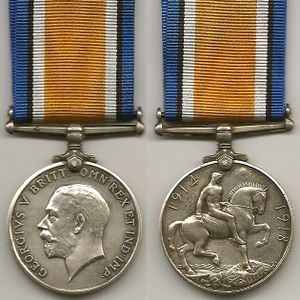Difference between revisions of "British War Medal"
From Our Contribution
| Line 1: | Line 1: | ||
| − | + | [[File:British_War_Medal_clean.jpg|thumb|WW1 British War Medal]] | |
| − | |||
| − | |||
| − | |||
| − | |||
| − | |||
| − | |||
| − | |||
| − | |||
| − | |||
| − | |||
| − | |||
| − | |||
| − | |||
| − | |||
| − | | | ||
| − | |||
| − | |||
| − | |||
| − | |||
| − | |||
| − | |||
| − | |||
| − | |||
| − | |||
| − | |||
| − | |||
| − | |||
| − | |||
| − | |||
| − | |||
| − | |||
| − | |||
| − | |||
| − | |||
| − | |||
| − | |||
==Eligibility== | ==Eligibility== | ||
Revision as of 12:36, 8 May 2017
Eligibility
The British War Medal was instituted in 1919 to recognise the successful conclusion of the First World War (1914-1918). Its coverage was later extended to recognise service until 1920, recognising mine clearing operations at sea, and participation in operations in North and South Russia, the eastern Baltic, Siberia, the Black Sea and the Caspian.
Description
The obverse of this medal shows the uncrowned left-facing profile of King George V by Sir Bertram Mackennal. The reverse of the medal depicts St George on horseback trampling underfoot the eagle shield of the Central Powers, and a skull and cross-bones (the emblems of death). Above, the sun has risen in victory. The figure is mounted on horseback to symbolise man's mind controlling a force of greater strength than his own, and thus alludes to the scientific and mechanical developments and machines which helped to win the war..[1]
Awarded to:
All those in categories other "Australia" as they did not leave our shores.
Notes
- ↑ http://medals.nzdf.mil.nz/category/h/h6.html Accessed 5 May 2017
